This recipe isn’t exactly my culinary Mount Everest. It’s more like, say, pilates: the thing I know I’d like if I did it but can’t quite get it up to try. Let’s break it down: there’s the separating of onions into layers, which looks at the outset like a royal pain. There’s the filling, which involves meat and lots of spices and raw rice, which – would it really cook in the sauce? I couldn’t be sure. And of course, there’s that sauce, which calls for tamarind puree, which I don’t always have just lying around the house. In sum, enough reasons to look longingly at a picture of the finished product, then turn the page — again, and again, and again.
Perhaps we should chalk it up to the refreshed ambition that comes with the turn of a new year. Or perhaps, a more likely story, I’m looking down the road a couple months and seeing little other than nursing, and diaper changing, and maybe fingerscrossedplease some sleeping, but not a lot of cooking. Whatever the impetus, I had been convinced. If ever there were a time to see whether Persian stuffed onions are worth the fuss, it was now.
And you know what? They really are worth the fuss. First of all, they’re not such a fuss. The onions, once boiled, are soft enough to separate easily. If you tear one of the layers (who me?), it doesn’t matter in the least. The filling, which always looked like a pain, is actually quite the opposite: turns out, you don’t need to cook it before stuffing the onions; it just cooks in the broth. (Lesson:Â snap judgment < actually reading the recipe.) And best of all, you can freeze the onions stuffed and uncooked, then bake them off at a later date. I’ll be making a massive batch of these to stow away for the road ahead.
Rosh Hashana Menu Planning: I’ve always flirted with Persian flavors for Rosh Hashana. For a few years running, I’ve served a main course of brisket with tamarind, and I almost always have some sort of sweet-sour vegetable to serve alongside. But this year, instead of just nodding toward the East, I’m building the entire menu around it.
The sweet and sour flavors of Persian cooking have always drawn me in. That they’re so friendly to pomegranates, squash, and other fall produce only makes my job easier. So a couple weeks back, I started digging through The Food of Life, my guide to Persian cuisine, in search of ideas. I’ve settled (at least for now) on the following menu for dinner:
- Deb’s Fig and Olive Oil Challah
- Persian Sumac Soup with Chickpea Dumplings (see Joan Nathan write all about those chickpea dumplings here)
- Greens with Apples, Black Lentils, Celery Root, Walnuts, and Mustard Vinaigrette (a riff on this and this)
- Tamarind Brisket (this year with lots of wine in the broth, because why not?)
- Persian Stuffed Onions
- Green Beans and Beets with Orange Segments and Sumac Vinaigrette
- Apples and Honey Cake
- AÂ sorbet (either apple-bourbon, maple-almond, or a riff on one of these)
What are you making? I’d love to see your favorite recipes and menu ideas below – let’s get the juices flowing.
Meanwhile, happy cooking, and happy new year. I hope the coming months are full of new adventures for all of us.
Persian Sweet and Sour Stuffed Onions
Inspired by recipes in The Food of Life and Aromas of Aleppo
Serves 4 as a main, 6 as a side dishI’ll be making two versions of these for our Rosh Hashana dinner: one vegetarian, one with ground lamb. I’ve given instructions for both versions below. One important note: the ratios here are hard to nail precisely, because every onion is different, and I don’t know how many layers your onions will have. You are very likely to find yourself with either extra onion layers or extra filling after making this recipe. Don’t sweat it. If you’ve got extra onion layers, dice them and add them to the sauce. If you have extra rice, cook it in a bit of broth and eat as a chef’s snack, or freeze it for another time. Lastly, because the quantities vary so much, you may want to double the recipe, just to be safe. Leftovers freeze very well uncooked, and can be baked off and eaten at a later date.
For the vegetarian version:
3 large or 4 medium yellow onions
1 1/2 cups long-grain rice
1/2 cup golden raisins, chopped
1 tablespoon dried dill
1 teaspoon dried mint
1 teaspoon cinnamon
1/2 teaspoon ground cumin
1/2 teaspoon ground cardamom
1/4 teaspoon ground cloves
1 teaspoon salt
2 teaspoon pomegranate molasses
2 teaspoons tomato pasteFor the meat filling:
All of the above, but use only 1 cup of rice
1/2 pound ground lamb (or beef)For the sauce:
2-3 tablespoons olive oil
1 1/2 cups tomato puree
2 cups vegetable or chicken broth
2 tablespoons tamarind puree or 2 teaspoons pomegranate molasses
2 teaspoons brown sugar
1/2 teaspoon cinnamon
1/4 cup dried apricots, coarsely chopped
1/2 teaspoon saltPrepare the onions: Bring a large pot of water to a boil over high heat. Meanwhile, use a paring knife to trim the very tip off of the non-root ends of the onions, and to scrape away the dry outer layers from the onions. Any layer that is even partially dried should be removed. Take care not to stab the onions’ flesh, and leave the root end of the onions intact.
Add the onions to the boiling water, and simmer for 20 minutes (25 minutes for larger onions) until flesh is very soft. Strain onions and set aside to cool. (To accelerate cooling process, transfer onions to an ice bath to cool.)
Prepare the filling:Â Soak rice in cold water for 30 minutes. Strain rice, then combine all ingredients – including raw ground meat, if using – in a large bowl. Use a fork or your fingers to ensure that everything is evenly distributed.
Stuff the onions: Fill a medium bowl halfway with water. I find it easiest to store the onion layers in water while working, so they don’t dry out. Set up a plate, tray, or other container to hold your filled onions.
Take an onion in your hand, with the ends at top and bottom. Use the paring knife to slice a deep slit from end to end, cutting through about three layers of onion. The carefully remove the layers of onion, using your fingers to separate each layer. If a layer rips, don’t sweat it – you can always patch over it once stuffed. Transfer onion layers to the bowl of water. If you can remove more sizable layers from the core of the onion, slice deeper with the knife and remove more layers. If not, set the core aside. Repeat with remaining onions.
Take an onion layer in your palm, fill it with a heaping tablespoon of filling, and wrap the layer around itself, loosely enclosing the filling. You want to leave room for the rice to expand, so don’t wrap the layers too tightly. Transfer the filled onion layer to your plate or tray, and continue filling remaining layers of onions, lining them up on the tray as you go.
Freezing the onions: At this stage, you can wrap the filled onions tightly and freeze them for a few months. Thaw completely in the refrigerator before proceeding.
Cook the onions:Â Depending on the size of your pan, you may need to brown the onions in batches. If using a large roaster, all onions should fit in one batch. If using a sauce pan, brown the onions in 2-3 batches, using one tablespoon of the olive oil for each batch.
Pour olive oil into a large deep sauce pan or ovenproof roaster, and set over medium heat. When oil shimmers, carefully transfer as many stuffed onions as will fit in the bottom of the pan. Cook for 3-5 minutes, until golden, then turn and cook another 3-5 minutes on the other side. If using a sauce pan, transfer browned onions back onto your tray, and repeat with remaining onions until all onions have been browned.
Once all onions have been browned, make your sauce in the bottom of the same pan – no need to remove the onions; they’ll be cooking in the sauce. Add all the sauce ingredients, shake the pan a bit to distribute the ingredients, give a little stir around the onions to help blend the sauce, and add any onions from the tray back into the pan. Cover with a lid or tin foil, and simmer over medium-low heat for 20 minutes, until broth has thickened and filling has fully cooked. Check at the halfway point: if your stove is very powerful, your liquid may evaporate more quickly, in which case you may need to add a few tablespoons of water to keep things moving. Feel free to add as much water as you need to keep the broth from sticking.
After 20 minutes of simmering, slice into an onion layer to ensure that everything looks fully cooked; if not, add another few tablespoons of water, shake to distribute, and cook another 5-10 minutes.
Serve hot, with sauce ladled over onions.
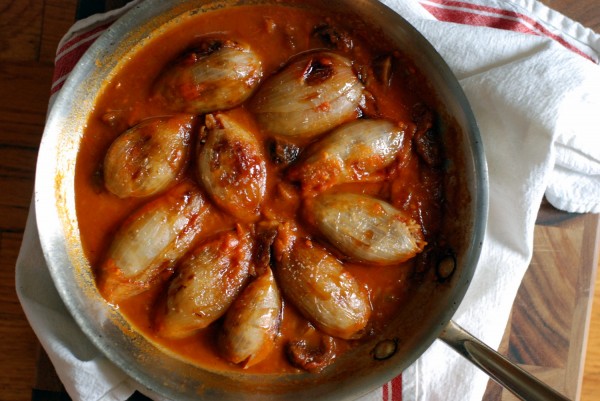
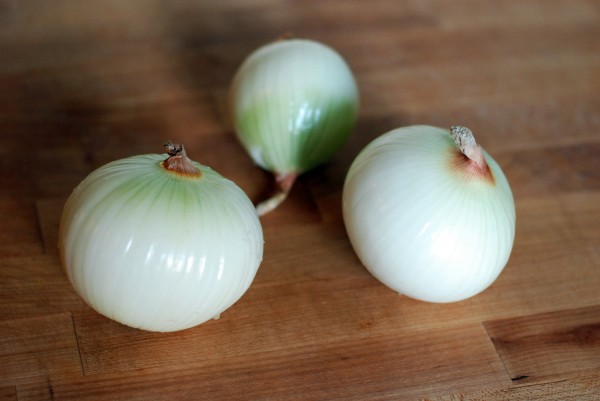
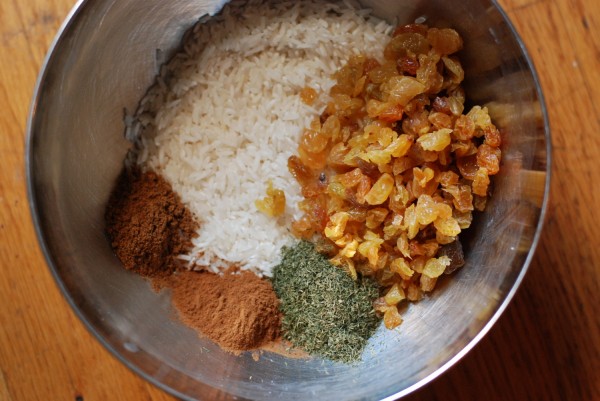

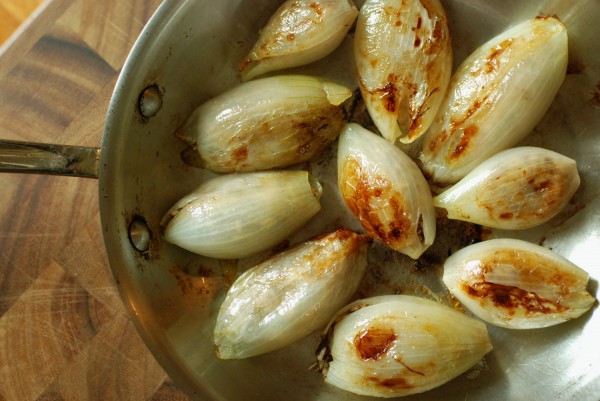
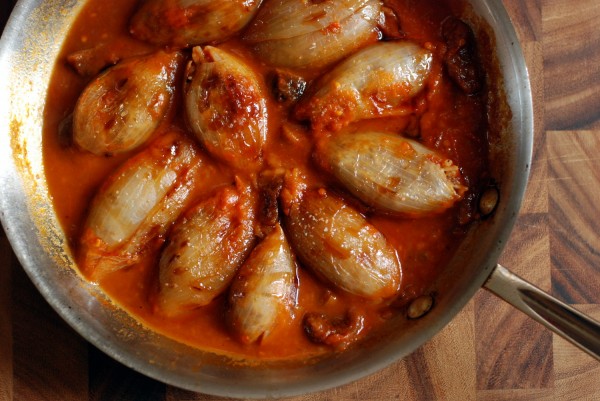
Comments on this entry are closed.
You’ll be surprised how much cooking you’ll get done in the first few months. Babies nap a lot.
There is a popup Jewish cuisine up here in Boston, and they are doing a Yemeni-inspired Rosh Hashana meal. The menu:
http://www.eventbrite.com/e/kitchen-kibitz-land-of-milk-and-honey-tickets-12946215479
That looks AMAZING. Thanks for sharing! May have to make something with hawaiij, since I have some homemade hawaiij lying around.
I have (and LOVE) the Aromas of Aleppo cookbook. In fact, I always stock tamarind puree because so many of her recipes call for it.
LOVE this vegetarian version. Thanks for sharing! And good luck transitioning into motherhood.
Man, I hope you get a napper! Josie is not a napper (woe, alas and alack), and I’m just finding my groove again, sort of. Might have to make time this weekend for stuffing some onions, though, because this looks awesome.
Yum. You just helped me decide what to make for Rosh Hashanah!!!
I am making Ottolenghi’s Za’atar Roast Chicken with Green Tahini Sauce. And to go along will be these gorgeous looking stuffed onions. Thank you for sending this recipe in time. Of course, chicken soup with matzah balls, chopped liver, and some beautiful greens. Dessert will be my version of an Italian Plum cake & a honey cake (in a Nordic Honeycomb pan with candy bees for decoration).
My wish for you and D is a very healthy baby and the easiest of deliveries. Looking forward to ‘kvelling’ and seeing pics. (I do not have facebook or any other social media so I hope some pics are posted on NDP)
L’shanah Tova
ism
Funny, I just saw a version of this on another website when looking for stuffed vegetable recipes for Rosh Hashana, but all the comments were about how the rice didn’t cook properly. I’ll try your version instead, thanks.
And, more importantly, b’shaah tova!